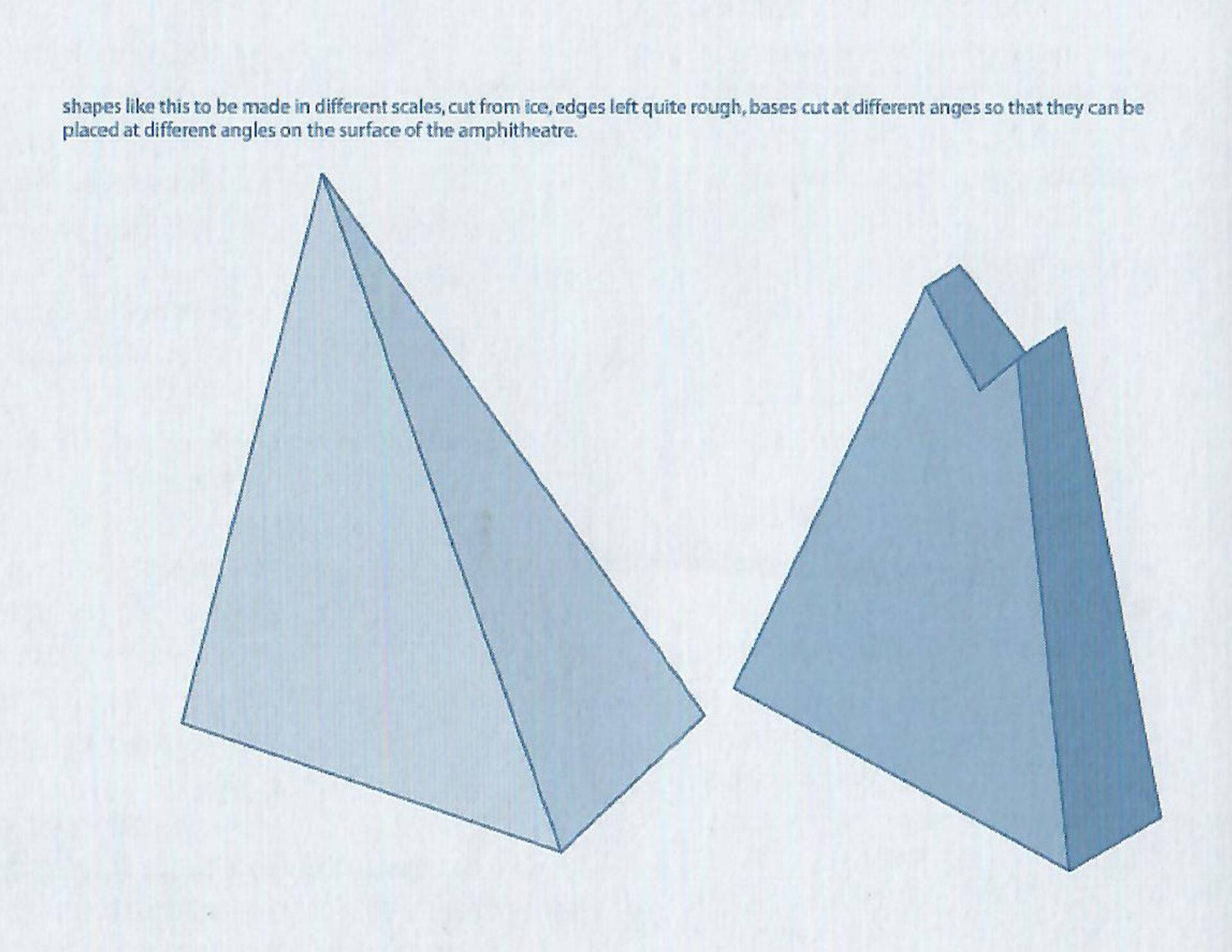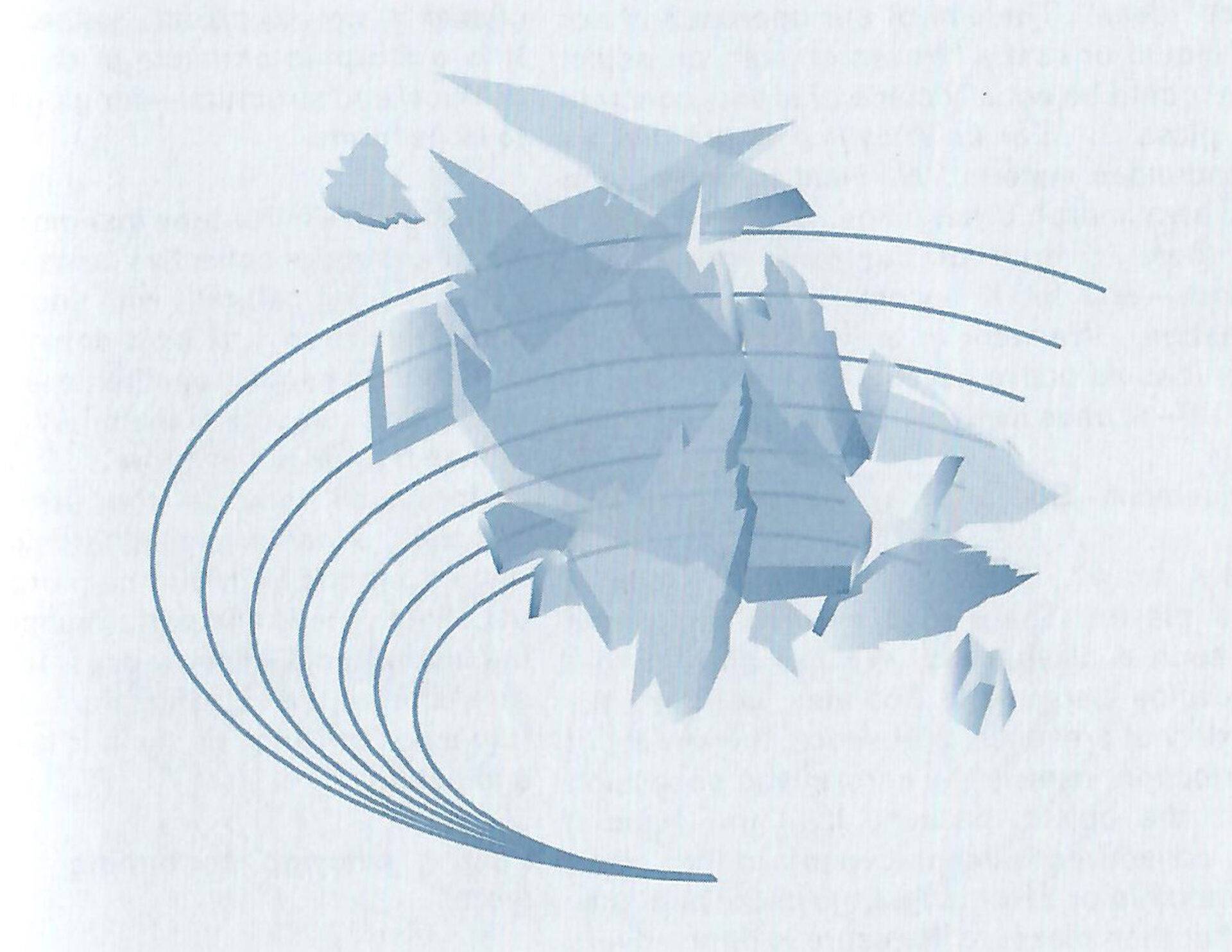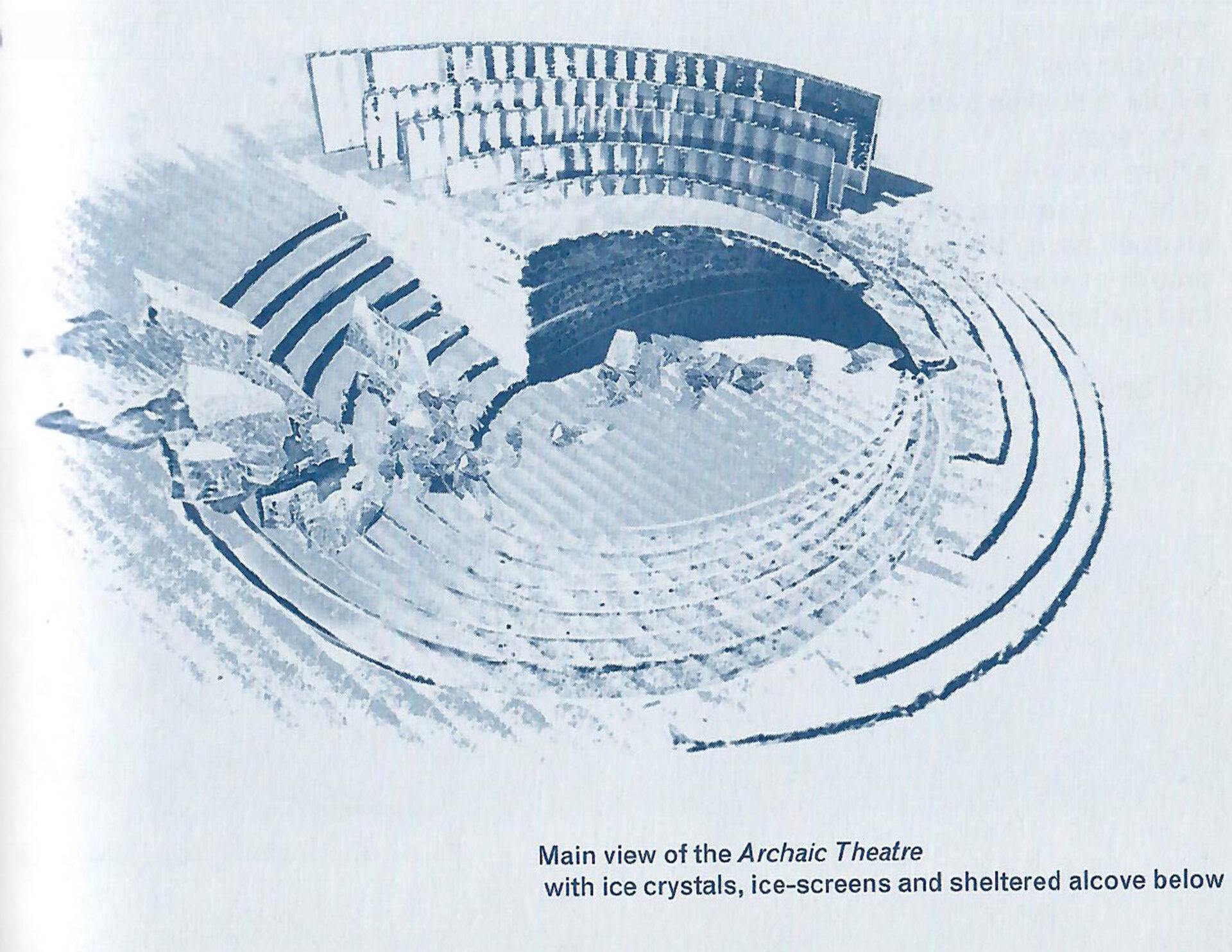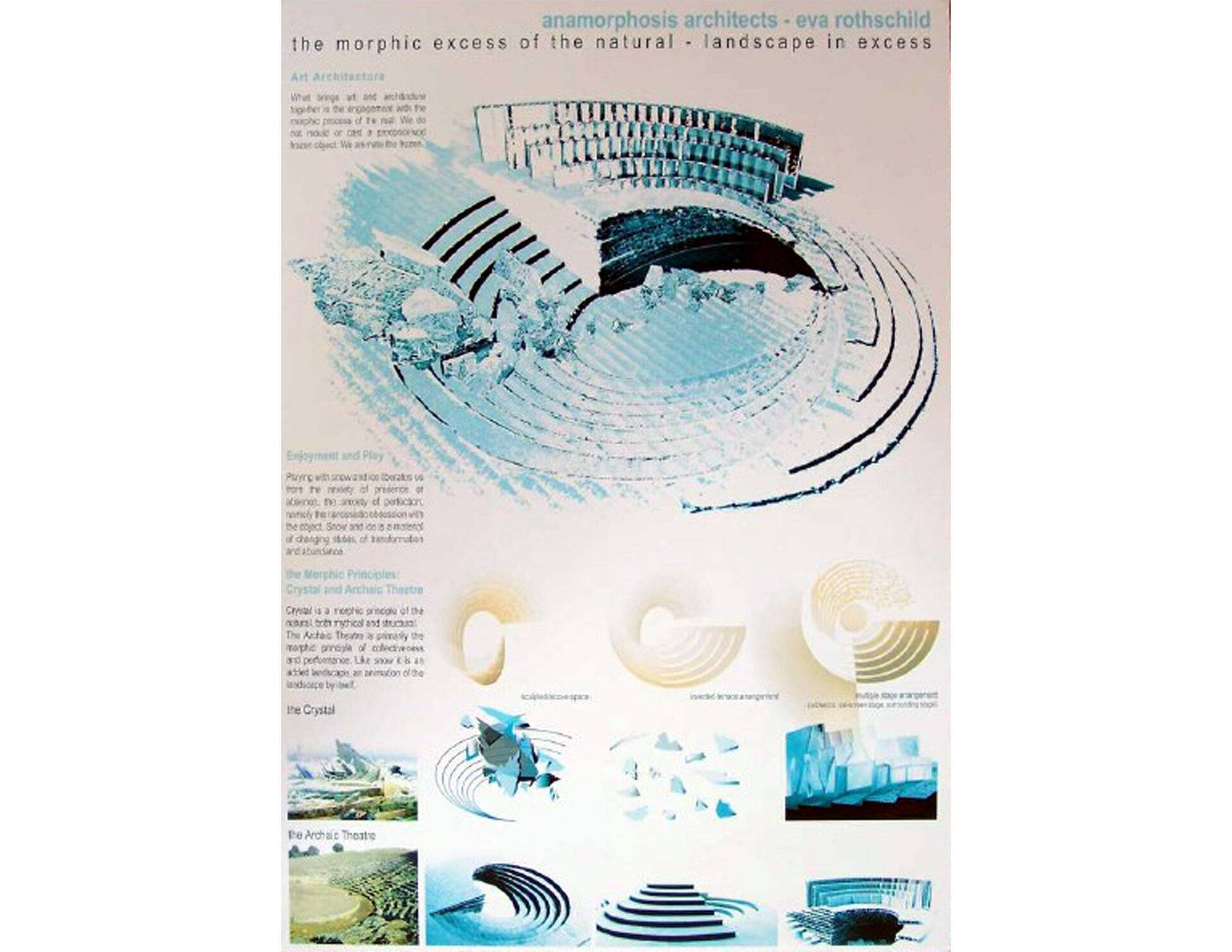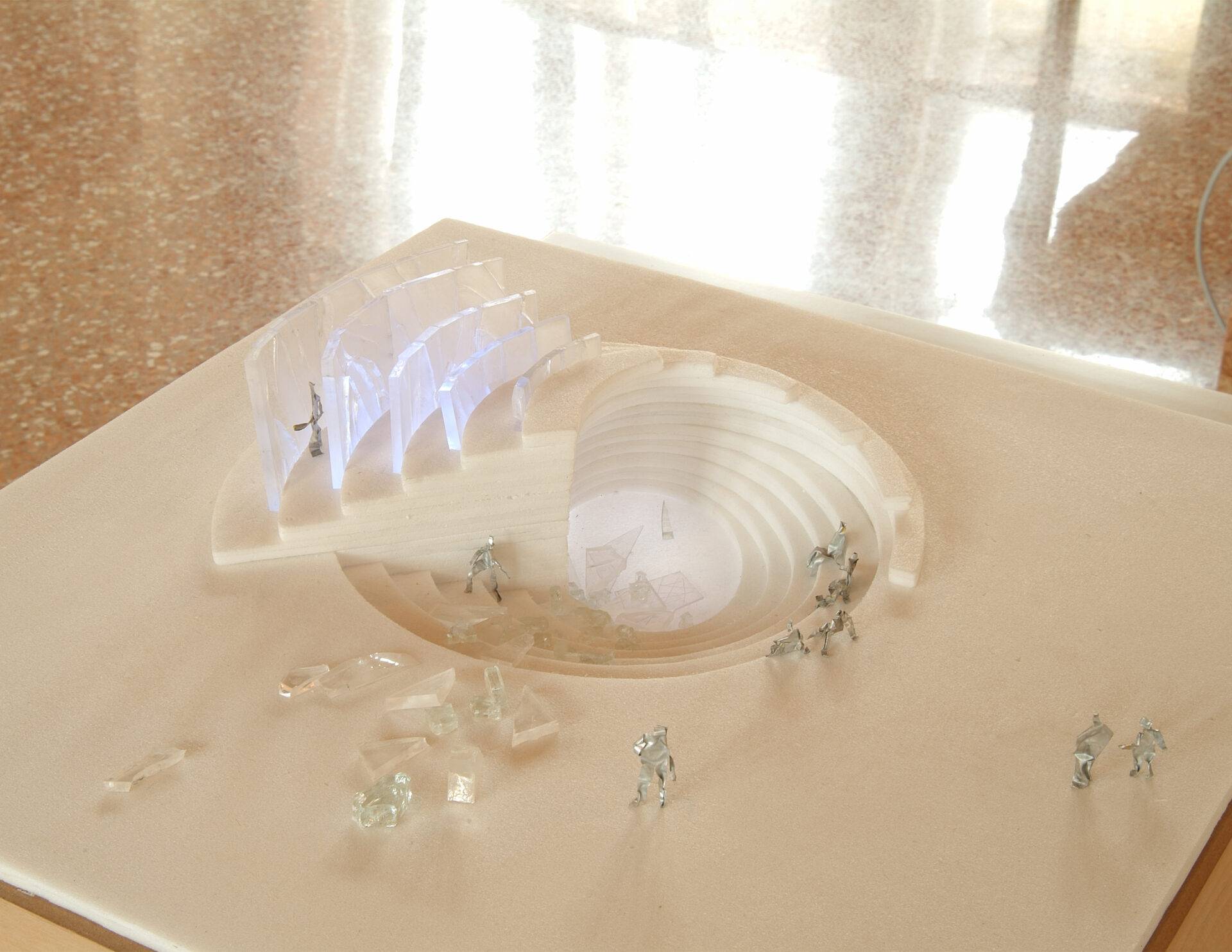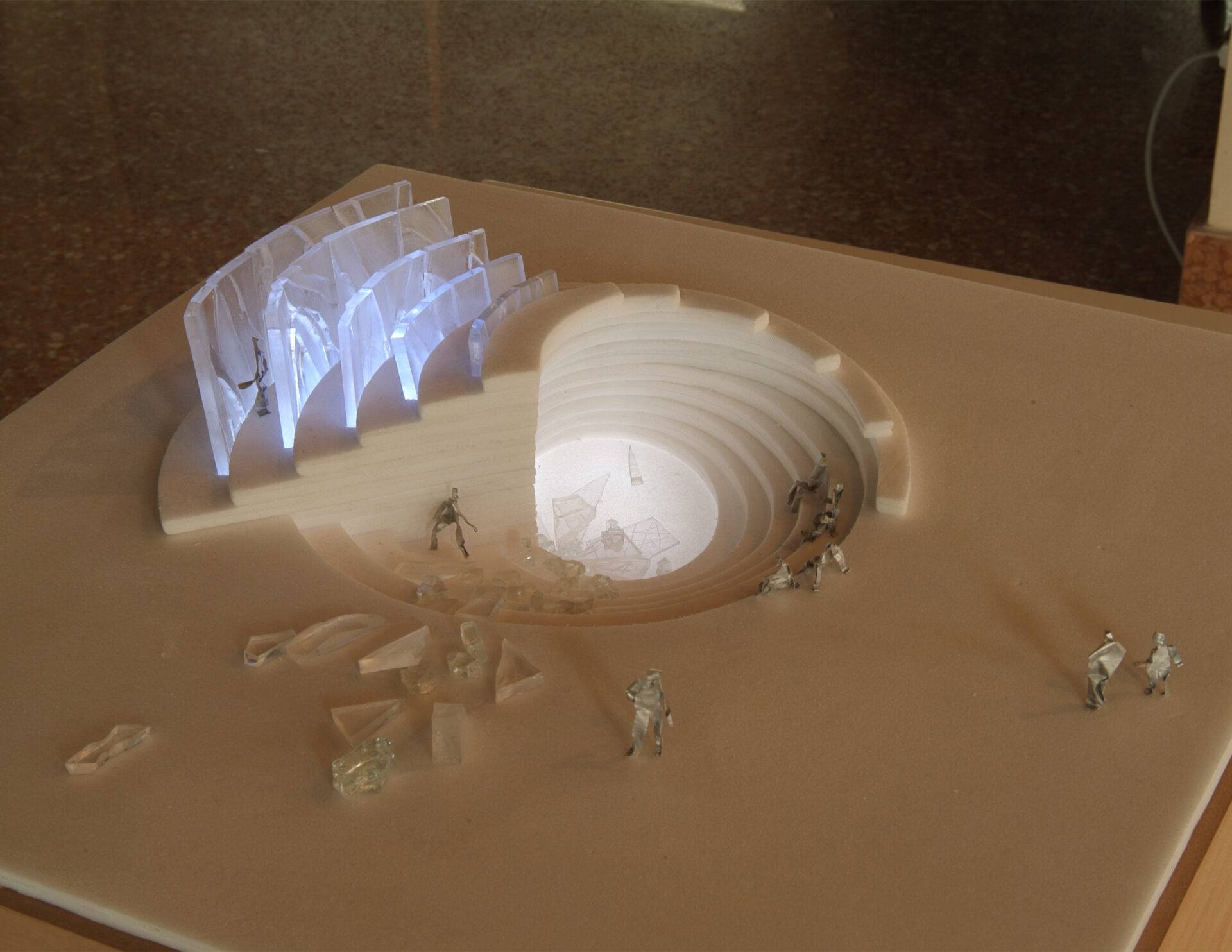THE MORPHIC EXCESS OF THE NATURAL OR LANDSCAPE IN EXCESS
2003
Eva Rothschild & Anamorphosis
Nikos Georgiadis:
Art Architecture
In our case, what brings art and architecture together is the engagement with the morphic process itself, that is a quiet, non-ironic, critique of both the formalist and counter-formalist paradigm. Both Eva and Anamorphosis have no preconceptions about form. We neither create/impose "our own" objects, nor deconstruct them, nor copy-paste them. Rather, we reveal form as the prose of the civilized world. And this alone suffices to create a common ground for collaboration, and why not, of exchanging positions, not just "ideas". The aim of our approach is not to mould or cast a "frozen object", an object that could be equally made of stone, concrete or glass... For us snow/ice is not just an unbounded material. We want to understand its own morphic language, discover what's in there in front of our eyes-not in our minds-and let it become our principle of creation. We want to animate the "frozen", see it as an active psychic process related to belief—at once mythic and ordinary.
Nikos Georgiadis:
Art Architecture
In our case, what brings art and architecture together is the engagement with the morphic process itself, that is a quiet, non-ironic, critique of both the formalist and counter-formalist paradigm. Both Eva and Anamorphosis have no preconceptions about form. We neither create/impose "our own" objects, nor deconstruct them, nor copy-paste them. Rather, we reveal form as the prose of the civilized world. And this alone suffices to create a common ground for collaboration, and why not, of exchanging positions, not just "ideas". The aim of our approach is not to mould or cast a "frozen object", an object that could be equally made of stone, concrete or glass... For us snow/ice is not just an unbounded material. We want to understand its own morphic language, discover what's in there in front of our eyes-not in our minds-and let it become our principle of creation. We want to animate the "frozen", see it as an active psychic process related to belief—at once mythic and ordinary.
Enjoyment-Space
Why snow? Snow/ice is lovely, amazing and playful. There is a psychic dimension in such a playfulness. We like playing with snow/ice because it liberates us from the anxiety of presence or absence, the anxiety of perfection, namely the narcissistic obsession with the object; because it is the material of collectiveness/sharedeness rather than ownership or belonging. Enjoyment and play rather than pleasure. Pleasure is directed and egocentric. Enjoyment is plural and fulfilling, a kind of spatial energy. Snow/ice is a material of changing states, of transformation, availability and abundance..., desire rather than need. It costs nothing, it melts and this perhaps is its most important principle. We make “objects” out of it, objects which are destined to be thrown, dissolved. In psychoanalytic terms snow/ice is a material of lack—it is shared, morphing and recurring.
The Morphic Principles: Crystal and Archaic Theatre
Snow is a falling, added landscape; a landscape in excess; an animation of the natural landscape by itself; a simultaneous sense of nature and the artifice. A possible theatre of the excess of the natural form. Eva's crystal is not an object, neither is the snow. It is a morphic principle of the natural: both mythical and structural-ranging from invisible to large forms.
The snow/ice landscape instigates a static and simultaneously collective sense of function.
When playing naturally with snow, we become static, don't run, just slow down. The material itself brings people together, even encourages interaction amongst them. We even make human figures out of snow ... Collectiveness/ performance indicate the second morphic principle. Anamorphosis' archaic theatre is not a symbolic form but the morphic principle of collectiveness and performance. It animates the landscape, like snow does. It is an organic extension of the existing landscape, turning it into a performance of itself. It is both artificial and natural.
Playing, enjoying, performing… performing more!
We invert the theatre twice
a) Outwardly: terraces become screens; a possible stage of a light/shadow play as people walk through them—an ice-screen theatre addressing to the far away visitors and city pedestrians.
b) Inwardly/outwardly: terraces become a sheltered alcove and a hill. A canopy theatre facing the surrounding projects/pavilions.
When it is "snowing" Crystal and Theatre speak the same morphic language; in two instances: material-ising and gathering, making and functioning...
When it is "snowing", art and architecture exchange roles: Architecture "decorates" and "sculpts" the landscape. Whereas Art "builds" and "materializes" it.
THE MORPHIC EXCESS OF THE NATURAL OR LANDSCAPE IN EXCESS
2003
Eva Rothschild & Anamorphosis
Nikos Georgiadis:
Art Architecture
In our case, what brings art and architecture together is the engagement with the morphic process itself, that is a quiet, non-ironic, critique of both the formalist and counter-formalist paradigm. Both Eva and Anamorphosis have no preconceptions about form. We neither create/impose "our own" objects, nor deconstruct them, nor copy-paste them. Rather, we reveal form as the prose of the civilized world. And this alone suffices to create a common ground for collaboration, and why not, of exchanging positions, not just "ideas". The aim of our approach is not to mould or cast a "frozen object", an object that could be equally made of stone, concrete or glass... For us snow/ice is not just an unbounded material. We want to understand its own morphic language, discover what's in there in front of our eyes-not in our minds-and let it become our principle of creation. We want to animate the "frozen", see it as an active psychic process related to belief—at once mythic and ordinary.
Nikos Georgiadis:
Art Architecture
In our case, what brings art and architecture together is the engagement with the morphic process itself, that is a quiet, non-ironic, critique of both the formalist and counter-formalist paradigm. Both Eva and Anamorphosis have no preconceptions about form. We neither create/impose "our own" objects, nor deconstruct them, nor copy-paste them. Rather, we reveal form as the prose of the civilized world. And this alone suffices to create a common ground for collaboration, and why not, of exchanging positions, not just "ideas". The aim of our approach is not to mould or cast a "frozen object", an object that could be equally made of stone, concrete or glass... For us snow/ice is not just an unbounded material. We want to understand its own morphic language, discover what's in there in front of our eyes-not in our minds-and let it become our principle of creation. We want to animate the "frozen", see it as an active psychic process related to belief—at once mythic and ordinary.
Enjoyment-Space
Why snow? Snow/ice is lovely, amazing and playful. There is a psychic dimension in such a playfulness. We like playing with snow/ice because it liberates us from the anxiety of presence or absence, the anxiety of perfection, namely the narcissistic obsession with the object; because it is the material of collectiveness/sharedeness rather than ownership or belonging. Enjoyment and play rather than pleasure. Pleasure is directed and egocentric. Enjoyment is plural and fulfilling, a kind of spatial energy. Snow/ice is a material of changing states, of transformation, availability and abundance..., desire rather than need. It costs nothing, it melts and this perhaps is its most important principle. We make “objects” out of it, objects which are destined to be thrown, dissolved. In psychoanalytic terms snow/ice is a material of lack—it is shared, morphing and recurring.
The Morphic Principles: Crystal and Archaic Theatre
Snow is a falling, added landscape; a landscape in excess; an animation of the natural landscape by itself; a simultaneous sense of nature and the artifice. A possible theatre of the excess of the natural form. Eva's crystal is not an object, neither is the snow. It is a morphic principle of the natural: both mythical and structural-ranging from invisible to large forms.
The snow/ice landscape instigates a static and simultaneously collective sense of function.
When playing naturally with snow, we become static, don't run, just slow down. The material itself brings people together, even encourages interaction amongst them. We even make human figures out of snow ... Collectiveness/ performance indicate the second morphic principle. Anamorphosis' archaic theatre is not a symbolic form but the morphic principle of collectiveness and performance. It animates the landscape, like snow does. It is an organic extension of the existing landscape, turning it into a performance of itself. It is both artificial and natural.
Playing, enjoying, performing… performing more!
We invert the theatre twice
a) Outwardly: terraces become screens; a possible stage of a light/shadow play as people walk through them—an ice-screen theatre addressing to the far away visitors and city pedestrians.
b) Inwardly/outwardly: terraces become a sheltered alcove and a hill. A canopy theatre facing the surrounding projects/pavilions.
When it is "snowing" Crystal and Theatre speak the same morphic language; in two instances: material-ising and gathering, making and functioning...
When it is "snowing", art and architecture exchange roles: Architecture "decorates" and
"sculpts" the landscape. Whereas Art "builds" and "materializes" it.
THE MORPHIC EXCESS OF THE NATURAL OR LANDSCAPE IN EXCESS
2003
Eva Rothschild & Anamorphosis
Nikos Georgiadis:
Art Architecture
In our case, what brings art and architecture together is the engagement with the morphic process itself, that is a quiet, non-ironic, critique of both the formalist and counter-formalist paradigm. Both Eva and Anamorphosis have no preconceptions about form. We neither create/impose "our own" objects, nor deconstruct them, nor copy-paste them. Rather, we reveal form as the prose of the civilized world. And this alone suffices to create a common ground for collaboration, and why not, of exchanging positions, not just "ideas". The aim of our approach is not to mould or cast a "frozen object", an object that could be equally made of stone, concrete or glass... For us snow/ice is not just an unbounded material. We want to understand its own morphic language, discover what's in there in front of our eyes-not in our minds-and let it become our principle of creation. We want to animate the "frozen", see it as an active psychic process related to belief—at once mythic and ordinary.
Nikos Georgiadis:
Art Architecture
In our case, what brings art and architecture together is the engagement with the morphic process itself, that is a quiet, non-ironic, critique of both the formalist and counter-formalist paradigm. Both Eva and Anamorphosis have no preconceptions about form. We neither create/impose "our own" objects, nor deconstruct them, nor copy-paste them. Rather, we reveal form as the prose of the civilized world. And this alone suffices to create a common ground for collaboration, and why not, of exchanging positions, not just "ideas". The aim of our approach is not to mould or cast a "frozen object", an object that could be equally made of stone, concrete or glass... For us snow/ice is not just an unbounded material. We want to understand its own morphic language, discover what's in there in front of our eyes-not in our minds-and let it become our principle of creation. We want to animate the "frozen", see it as an active psychic process related to belief—at once mythic and ordinary.
Enjoyment-Space
Why snow? Snow/ice is lovely, amazing and playful. There is a psychic dimension in such a playfulness. We like playing with snow/ice because it liberates us from the anxiety of presence or absence, the anxiety of perfection, namely the narcissistic obsession with the object; because it is the material of collectiveness/sharedeness rather than ownership or belonging. Enjoyment and play rather than pleasure. Pleasure is directed and egocentric. Enjoyment is plural and fulfilling, a kind of spatial energy. Snow/ice is a material of changing states, of transformation, availability and abundance..., desire rather than need. It costs nothing, it melts and this perhaps is its most important principle. We make “objects” out of it, objects which are destined to be thrown, dissolved. In psychoanalytic terms snow/ice is a material of lack—it is shared, morphing and recurring.
The Morphic Principles: Crystal and Archaic Theatre
Snow is a falling, added landscape; a landscape in excess; an animation of the natural landscape by itself; a simultaneous sense of nature and the artifice. A possible theatre of the excess of the natural form. Eva's crystal is not an object, neither is the snow. It is a morphic principle of the natural: both mythical and structural-ranging from invisible to large forms.
The snow/ice landscape instigates a static and simultaneously collective sense of function.
When playing naturally with snow, we become static, don't run, just slow down. The material itself brings people together, even encourages interaction amongst them. We even make human figures out of snow ... Collectiveness/ performance indicate the second morphic principle. Anamorphosis' archaic theatre is not a symbolic form but the morphic principle of collectiveness and performance. It animates the landscape, like snow does. It is an organic extension of the existing landscape, turning it into a performance of itself. It is both artificial and natural.
Playing, enjoying, performing… performing more!
We invert the theatre twice
a) Outwardly: terraces become screens; a possible stage of a light/shadow play as people walk through them—an ice-screen theatre addressing to the far away visitors and city pedestrians.
b) Inwardly/outwardly: terraces become a sheltered alcove and a hill. A canopy theatre facing the surrounding projects/pavilions.
When it is "snowing" Crystal and Theatre speak the same morphic language; in two instances: material-ising and gathering, making and functioning...
When it is "snowing", art and architecture exchange roles: Architecture "decorates" and "sculpts" the landscape. Whereas Art "builds" and "materializes" it.
THE MORPHIC EXCESS OF THE NATURAL OR LANDSCAPE IN EXCESS
2003
Eva Rothschild & Anamorphosis
Nikos Georgiadis:
Art Architecture
In our case, what brings art and architecture together is the engagement with the morphic process itself, that is a quiet, non-ironic, critique of both the formalist and counter-formalist paradigm. Both Eva and Anamorphosis have no preconceptions about form. We neither create/impose "our own" objects, nor deconstruct them, nor copy-paste them. Rather, we reveal form as the prose of the civilized world. And this alone suffices to create a common ground for collaboration, and why not, of exchanging positions, not just "ideas". The aim of our approach is not to mould or cast a "frozen object", an object that could be equally made of stone, concrete or glass... For us snow/ice is not just an unbounded material. We want to understand its own morphic language, discover what's in there in front of our eyes-not in our minds-and let it become our principle of creation. We want to animate the "frozen", see it as an active psychic process related to belief—at once mythic and ordinary.
Nikos Georgiadis:
Art Architecture
In our case, what brings art and architecture together is the engagement with the morphic process itself, that is a quiet, non-ironic, critique of both the formalist and counter-formalist paradigm. Both Eva and Anamorphosis have no preconceptions about form. We neither create/impose "our own" objects, nor deconstruct them, nor copy-paste them. Rather, we reveal form as the prose of the civilized world. And this alone suffices to create a common ground for collaboration, and why not, of exchanging positions, not just "ideas". The aim of our approach is not to mould or cast a "frozen object", an object that could be equally made of stone, concrete or glass... For us snow/ice is not just an unbounded material. We want to understand its own morphic language, discover what's in there in front of our eyes-not in our minds-and let it become our principle of creation. We want to animate the "frozen", see it as an active psychic process related to belief—at once mythic and ordinary.
Enjoyment-Space
Why snow? Snow/ice is lovely, amazing and playful. There is a psychic dimension in such a playfulness. We like playing with snow/ice because it liberates us from the anxiety of presence or absence, the anxiety of perfection, namely the narcissistic obsession with the object; because it is the material of collectiveness/sharedeness rather than ownership or belonging. Enjoyment and play rather than pleasure. Pleasure is directed and egocentric. Enjoyment is plural and fulfilling, a kind of spatial energy. Snow/ice is a material of changing states, of transformation, availability and abundance..., desire rather than need. It costs nothing, it melts and this perhaps is its most important principle. We make “objects” out of it, objects which are destined to be thrown, dissolved. In psychoanalytic terms snow/ice is a material of lack—it is shared, morphing and recurring.
The Morphic Principles: Crystal and Archaic Theatre
Snow is a falling, added landscape; a landscape in excess; an animation of the natural landscape by itself; a simultaneous sense of nature and the artifice. A possible theatre of the excess of the natural form. Eva's crystal is not an object, neither is the snow. It is a morphic principle of the natural: both mythical and structural-ranging from invisible to large forms.
The snow/ice landscape instigates a static and simultaneously collective sense of function.
When playing naturally with snow, we become static, don't run, just slow down. The material itself brings people together, even encourages interaction amongst them. We even make human figures out of snow ... Collectiveness/ performance indicate the second morphic principle. Anamorphosis' archaic theatre is not a symbolic form but the morphic principle of collectiveness and performance. It animates the landscape, like snow does. It is an organic extension of the existing landscape, turning it into a performance of itself. It is both artificial and natural.
Playing, enjoying, performing… performing more!
We invert the theatre twice
a) Outwardly: terraces become screens; a possible stage of a light/shadow play as people walk through them—an ice-screen theatre addressing to the far away visitors and city pedestrians.
b) Inwardly/outwardly: terraces become a sheltered alcove and a hill. A canopy theatre facing the surrounding projects/pavilions.
When it is "snowing" Crystal and Theatre speak the same morphic language; in two instances: material-ising and gathering, making and functioning...
When it is "snowing", art and architecture exchange roles: Architecture "decorates" and "sculpts" the landscape. Whereas Art "builds" and "materializes" it.
ARTWORK
ARTWORK
ARTWORK
